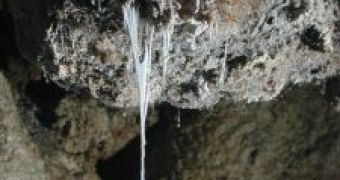Snots can play in nature unsuspected roles.
If you enter a cave, you can encounter snot chandeliers that hang from cave ceilings and coat the floors with thick mats. These snots are in fact natural bacteria cultures.
Now scientists have discovered that the bacteria snots are an active factor of expanding the subterranean world. "We really are able to implicate microorganisms in speeding up cave formation," said Jennifer Macalady of Pennsylvania State University.
If bacteria miss, caves expand like that: as oxygen-rich rainwater seeps below the ground's surface it mixes with hydrogen sulfide (which smells like rotten eggs) rich underground water. The oxygen transforms hydrogen sulfide into sulfuric acid, which dissolved surrounding lime rocks, process that over time creates large cave systems.
Snot layers of sulfur-consuming bacteria complicate the process. Within just about 1 mm, multiple layers of bacteria live, each encased into its own niche. The outer layer is of aerobic bacteria, which use oxygen and hydrogen sulfide to get energy. Other bacteria are anaerobic (do not stand the oxygen) and live on the inner layers. These layers transform the sulfuric acid to hydrogen sulfide and a complete sulfur cycle emerges in the snot along a cave wall or floor. "One type of biofilm (bacteria layer), called a snottite because of its appearance, has a pH of zero or one," said Daniel Jones, of Penn State. That is the maximum acidity, due to the presence of sulfuric acid, one of the most powerful acids.
The team measured chemical reactions in millimeter-thick layers of the walls and floors as well as in the streams. Bacteria on the floors and in streams transformed loads of hydrogen sulfide into acid that washed down the stream to dissolve any limestone it contacted. "Stream biofilms are responsible for the majority of sulfide disappearance in streams," Jones said.
The discoveries could explain the activity of other biofilms, too, included teeth bacteria plaque and those that corrode steel ships hulls. Snottites like communities may also thrive under the surface of Mars, where water was found.

 14 DAY TRIAL //
14 DAY TRIAL //